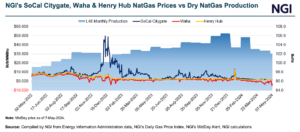LNG | LNG Insight | Markets | NGI All News Access
North American Natural Gas Marketers Report Strong Sales, LNG Demand in Second Quarter
© 2024 Natural Gas Intelligence. All rights reserved.
ISSN © 1532-1231 | ISSN © 2577-9877 |

Markets
Natural gas futures on Tuesday notched a fourth-straight day of gains – albeit barely – on maintenance-induced reductions to already lower production activity. At A Glance: Production hits May low Weather forecasts mixed LNG steadies above 12 Bcf/d Coming off a cumulative gain of more than 25 cents over the prior three sessions, the June…
May 7, 2024Earnings
By submitting my information, I agree to the Privacy Policy, Terms of Service and to receive offers and promotions from NGI.